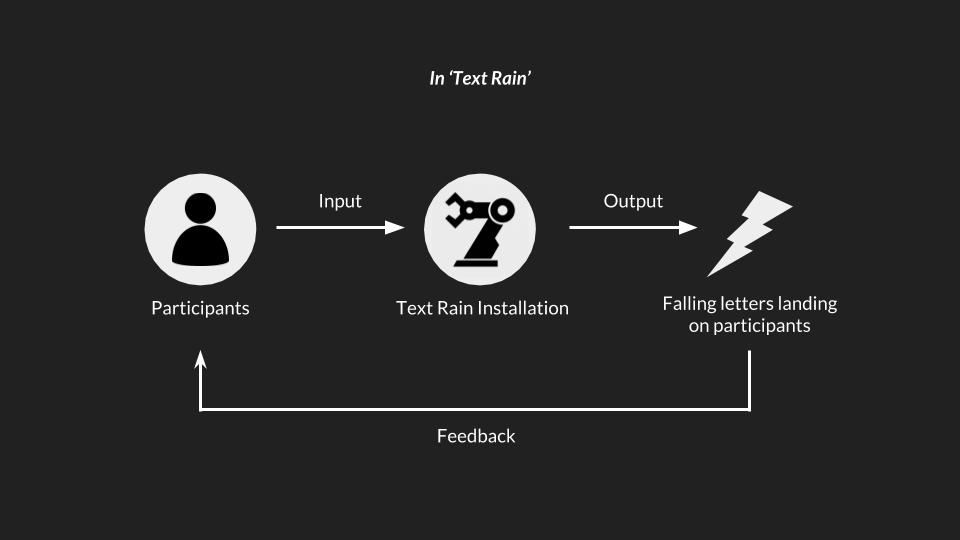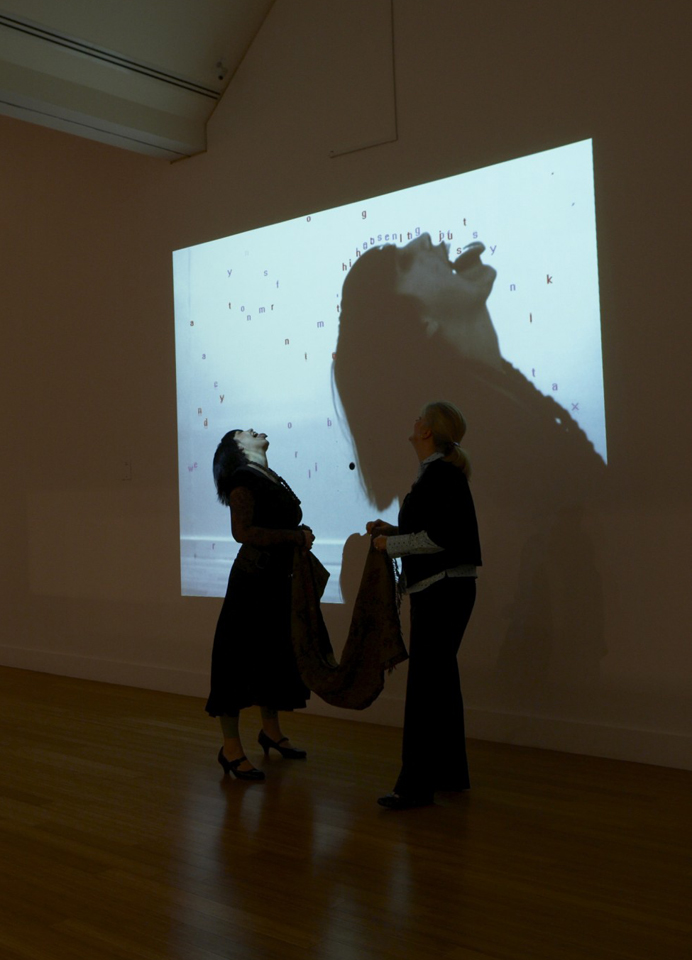Introduction to selected artist and artwork

Text Rain is an interactive installation created by Camille Utterback and Romy Achituv. Camille Utterback is an internationally acclaimed artist and pioneer in the field of digital and interactive art. Her works explores the aesthetic and experiential possibilities of linking computational systems to the human movement and physicality in visually layered ways.
Text Rain is an interactive installation in which audiences use the familiar instrument of their bodies, to do what seems magical – to lift and play with falling letters that do not exist.
In this essay, I will be using the theories of interactivity (cybernetics and behavioural art) to discuss Text Rain.
Cybernetics and Entropy in Text Rain
As Text Rain relies heavily on the interaction of audiences, Utterback and Achituv had to create a system that would respond to the body movements of the audiences in real time.


In this installation, audiences stand or move in front of a large projection screen. On the screen, they see a mirrored video projection of themselves in black and white, combined with a colour animation of falling letters. Like rain or snow, the letters appear to land on audiences’ heads and arms. The letters respond to the audiences’ motions and can be caught, lifted, and then let fall again. The falling text will ‘land’ on anything darker than a certain threshold, and ‘fall’ whenever that obstacle is removed. If a participant accumulates enough letters along their outstretched arms, or along the silhouette of any dark object, they can sometimes catch an entire word, or even a phrase. The falling letters are not random, but form lines of a poem about bodies and language. ‘Reading’ the phrases in the Text Rain installation becomes a physical as well as a cerebral endeavour.
“The figures themselves (automata) have no trace of communication with the outer world, except this one-way stage of communication with the pre-established mechanism of the music box. They are blind, deaf, and dumb, and cannot vary their activity in the least from the conventionalized pattern.” – Norbert Wiener
The conventionalised pattern in this case is the animation of falling letters. They will continue to fall to the ground until a participant stand in front of the large screen, sending a signal to the installation to cause the letters to fall on the projected image of the participant instead.
The theory of entropy can be found in Text Rain too. As the movements of the audiences are unpredictable, it is impossible to determine where each alphabet would land. Hence, giving the installation a natural and organic feel as the falling of alphabets closely resemble snowfall. Even though the lines of poem that will string together when audiences stand still are already predetermined by Camille Utterback and Romy Archituv, the order of their appearance is indeterminate.

There are many factors that would affect how these lines would be able to string together, this in turns affect the way audiences perceive the meaning behind Text Rain. Some of these factors include:
- How long audiences decide to stand still for – If they are unable to stand still long enough for the phrases and sentences to finish forming, they will not be able make the connection between their physical movement and meaning of the poem.
- Surface area for alphabets to land on – smaller surface areas allow short phrases and words to form, while bigger surface areas allow sentences to form.
Text Rain as behavioural art
The characteristics of Text Rain described in the previous section support it as a behavioural art. Text Rain is constantly changing and responding to the participant’s movements in real time.
“The participational, inclusive form of art has as its basic principle “feedback,” and it is this loop which makes of the triad artist/artwork/observer an integral whole. For art to switch its role from the private, exclusive arena of a rarefied elite to the public, open field of general consciousness, the artist has had to create more flexible structures and images offering a greater variety of readings than were needed in art formerly.” – Roy Ascott
The whole idea of interactive art, as its name suggests, is to interact with the audience. Many interactive artworks mainly engage with the audience’s eyes and hands, but rarely the entire body. Text Rain goes a step further by engaging with the entirely of the audience’s body. Often, some would be too shy to actively engage with the artwork, especially not when they are in a public space. However, Text Rain is so captivating that the audience are no longer self-conscious about their body movements because they are too fascinated by how their bodies affect the projected digital media.
By engaging the audience’s entire bodies and its seamless reaction to the audience’s movements, Text Rain can create a highly immersive experience. It is immersive in the sense that it enables the audiences to feel as if they have stepped into a magical place that does not exist. This immersive experience does not take away the experience of being present in the moment. In fact, it encourages audiences to do exactly that since the audiences would be conscious of how their bodies would interact with the artwork. They would be eager to do different poses with their bodies to see what would happen. Even though they are conscious of their body movements, they are not self-conscious because they no longer see themselves in the real world, but in the magical world that Utterback and Achituv had created. More than just interacting with an artwork, for just a short moment, the audiences believe that they have entered the artwork itself.


Conclusion
Overall, I believe that Text Rain encompasses the qualities that a successful interactive artwork should possess:
- Simple feedback system – One simply stands in front of the projection and move their bodies as they please. This reaction is intuitive and doesn’t require much explanation or create any confusion.
- Meaningful and fun at the same time – Contains the element of surprise when strings of phrases and sentences form when audiences stand still for a period of time.
- Unpredictability – Arouses curiosity in audiences and encourages them to interact with the artwork in new and creative ways.
- Immersive – Audiences can let go of their self-consciousness and engage fully with the artwork.
Image sources
- https://m.post.naver.com/viewer/postView.nhn?volumeNo=8058933&memberNo=24985926
- http://camilleutterback.com/projects/text-rain/
- http://golancourses.net/2013/projects/samgruberupkittextrain/
